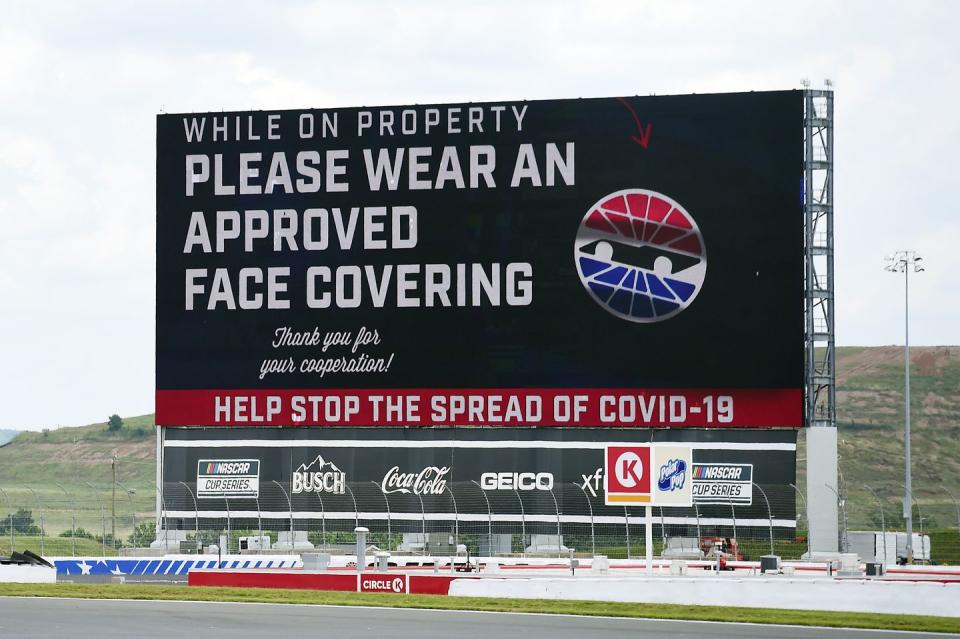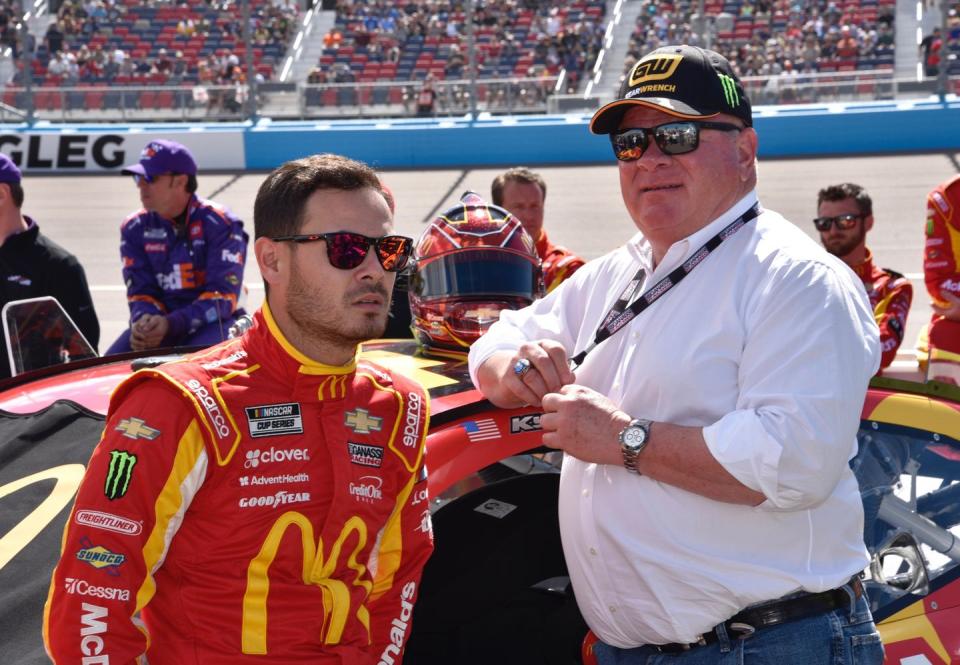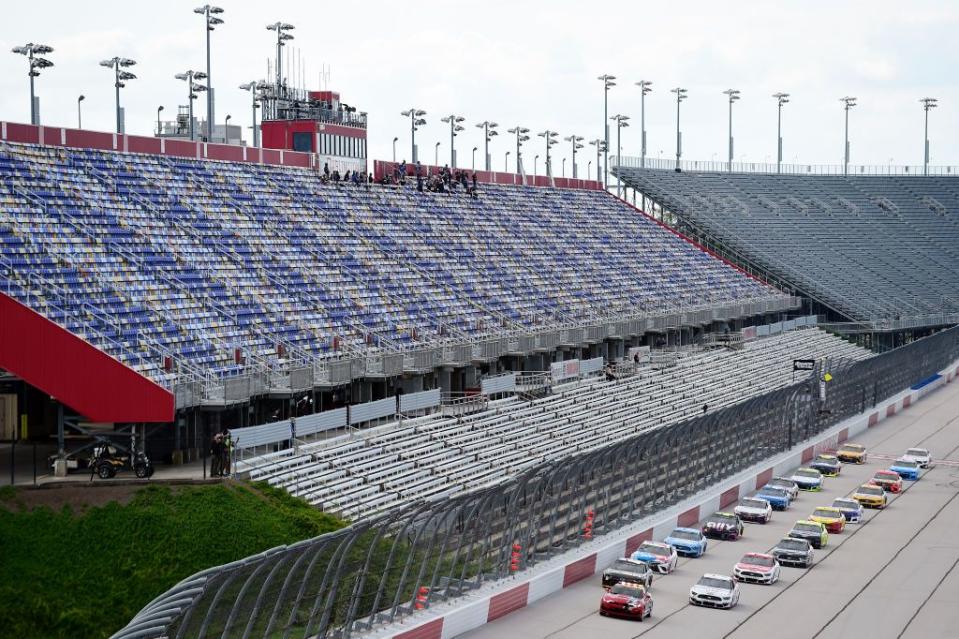How NASCAR Stared Down the COVID-19 Pandemic

- Oops!Something went wrong.Please try again later.
Due to the COVID-19 pandemic, NASCAR suspended operations on March 13, 2020, still 32 races still left to be run on its schedule.
Early into the shutdown, it was virtual racing that kept at least some fans entertained.
Creative scheduling, races held without fans in the stands allowed NASCAR to complete a full-schedule of 94 races for its three top national touring series during that most unusual year.
In 2020, COVID-19 changed everything.
The 2020 NASCAR season started off like any other. The Daytona 500 was completed in front of a sellout crowd. Three races followed suit at Las Vegas Motor Speedway, Auto Club Speedway and Phoenix Raceway.
Everything—and that included NASCAR—changed in March as COVID-19 cases exploded worldwide. Government agencies, businesses and sports announced different levels of shutdown, and NASCAR suspended operations on March 13 that year with 32 races still left to be run. With mask mandates, test kits and social distancing suddenly becoming a part of everyday conversations, sports leagues and fans alike were asking the same question.
“What happens next?”

During the most uncertain and challenging circumstances, NASCAR stepped up and crafted a plan and did its best to safely navigate through a global pandemic. It was the first professional sports series to resume operations and hold events after the lockdown began.
Early into the shutdown, it was virtual racing that kept at least some fans entertained. NASCAR and the popular racing simulator computer program iRacing teamed up to create the eNASCAR iRacing Pro Invitational Series. FOX broadcasted these online races, just as if they were real ones. The made-for-TV virtual racing turned out to be a temporary success for NASCAR and and gave sports-starved fans at least something to watch.
NASCAR and iRacing held seven of these virtual races featuring Cup drivers.
There were speed bumps, to be sure. The virtual racing wasn't exactly a huge success for Cup driver Kyle Larson, who got caught using a racial slur during one of the virtual races. The slip was captured online on April 12 and quickly spread through social media.

Chip Ganassi Racing responded by suspending Larson the next morning, while issuing the following statement:
"We are extremely disappointed by what Kyle said last night during an iRacing event. The words that he chose to use are offensive and unacceptable. As of this moment we are suspending Kyle without pay while we work through this situation with all appropriate parties."
NASCAR also suspended Larson and ordered the driver to attend sensitivity training and issued a statement of its own:
"NASCAR has made diversity and inclusion a priority and will not tolerate the type of language used by Kyle Larson during Sunday’s iRacing event. Our Member Conduct Guidelines are clear in this regard, and we will enforce these guidelines to maintain an inclusive environment for our entire industry and fan base."
Larson did his best to control the damage.
"I just want to say I'm sorry," Larson said. "You know, last night I said the word that should never, ever be said. There's no excuse for that. I wasn't raised that way. It's just an awful thing to say.
"I feel very sorry for my family, my friends, my partners, the NASCAR community and especially the African-American community. I understand the damage is probably unrepairable. I own up to that. I just want to let you all know how sorry I am.
"I hope everyone is staying safe in these crazy times."
The apology wasn't enough for sponsors McDonald's, Credit One Bank and Chevrolet, who announced they would be dropping support of Larson's ride. The sponsor pullout was too much for team owner Chip Ganassi, who fired Larson some 48 hours after the incident.
As for NASCAR, the series was back up and running for real on May 17, when the series returned to action at Darlington Raceway. Except this time, things looked a little different. Drivers and team members were to receive daily COVID tests and stay within the “bubble” of restricted access. NASCAR had to run Cup Series races without having a single fan in the stands. Under COVID guidelines at the time, fans were not allowed to attend live sporting events, outside or inside.
There were also positive tests. Seven-time champion Jimmie Johnson became the first Cup Series driver to miss a race after he tested positive the week of the Brickyard 400. It was the first race Johnson missed in his career.

Over the next several weeks, NASCAR held mid-week races to make up for the lost time. Series officials were determined to complete the full season of 36 races, and they did just that.
When Chase Elliott crossed the finish line at Phoenix Raceway on November 8, NASCAR had completed all 94 races for its three top national touring series during that calendar year. NASCAR was the only major sports organization in the U.S. to complete its entire schedule in 2020.
NASCAR president Steve Phelps said lessons were learned.
“I would suggest this is the single most difficult year that we’ve faced as a sport,” Phelps said in his 2020 annual state of the sport address. “I think we showed this year as a sport that we did as good or a better job than any sport did, frankly, getting back early and often. What we have done during this global pandemic is nothing short of remarkable.
"I believe we’re stronger as a sport today than when we were pre-COVID.”

